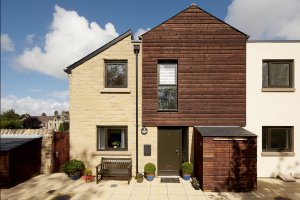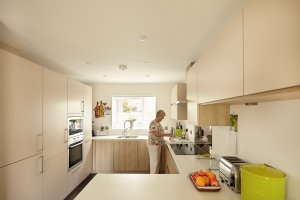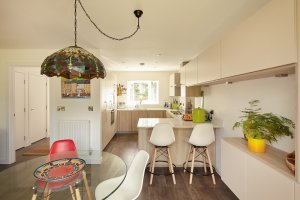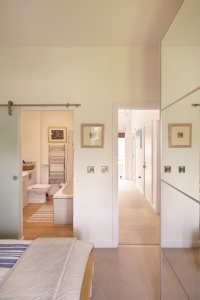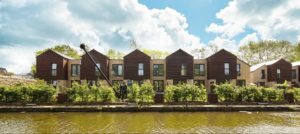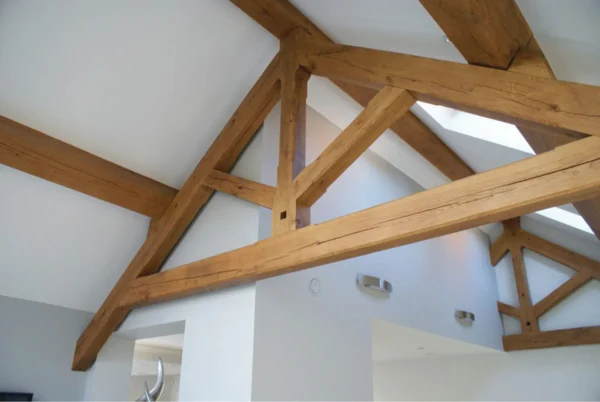Innovative Waterside Custom Build Home
Nicola and Jim Combe had lived in and appreciated the qualities of new-build developments for many years.
So when they started their search for their dream home and saw the brand new Aldcliffe Yard canal-side development in Lancaster advertised in a local newspaper, they jumped at the chance to find out more about the opportunity.
“We initially considered tackling a traditional self-build, but thought it would be too difficult,” says Nicola. “When we set up a meeting with housing developers H20 we didn’t even know there was a custom build route available. However, after learning more about the scheme we realised that it would be a good compromise between running your own project and buying off-plan.”
The custom build route is inspired by continental models, and aims to offer a reduced-risk path to creating your own home. Typically, schemes are enabled by either a specialist developer or a local council.
- NamesJim & Nicola Combe
- LocationLancaster
- Type of projectCustom build
- StyleContemporary
- Construction methodTimber frame
- Project route Developer-enabled custom build
- Plot size260m2
- Serviced plot cost£141,250 (bought 2014)
- House size90m2
- Project cost£129,918
- Total cost £271,168
- Cost per m2£1,444
- Vat reclaim£6,000
- Construction time85 weeks
- Current value£300,000
Elements such as key services (electricity, water and drainage) and access are usually already in place (or easy to arrange) and accounted for in the plot purchase price. Different projects offer different levels of customisation in terms of the exterior design, layouts and interior fit-out.
Plots & planning
Working with sister company Plot, H20 already had outline planning permission for the development, which consisted of 14 new three- or four-bedroom family homes, as well as a smattering of conversion opportunities for a number of grade II listed stone canal buildings.
Several of the new houses were earmarked for a custom build approach, with purchasers able to buy their plot outright to give them control over the internal layout and design. Each scheme would be constructed by H20’s team of professional builders – removing the stress of having to arrange your own contractors.
“We were one of the first to show any interest in the custom build options, so we were able to choose the best plot for our needs,” says Jim. “Before being accepted onto the scheme, we had to prove that we could buy the plot outright and afford the build without having to sell our own home. They didn’t want anyone in a chain.”
In March 2014, the couple arranged a self-build mortgage via Buildstore. “The concept of custom homes was still relatively new at that point, even for the specialist mortgage providers,” says Nicola.
“We were asked quite a few questions that were really only appropriate for full self-builds, which was slightly frustrating. Although we felt like guinea pigs at the time, we did finally manage to secure a mortgage.”
Since then, more lenders have launched into the custom build market – including the likes of Hanley Economic, Bath Building Society and Virgin Money.
Home design
Once Jim and Nicola had their finances in place, they were able to sign up to the Aldcliffe Yard scheme. The couple then had a month to make changes to the design before H20 submitted an updated planning application to the local authority on their behalf.
“The site is in a conservation area, so we were limited in terms of how much external customisation we could do,” says Nicola. “We were given a computerised 3D plan with a standard layout that we could play around with and discuss with H20’s architect until we got the interior layout we wanted.”
Read more: How to get planning permission in a conservation area
The couple did feel rushed at times, having only about five weeks to make design changes after putting down their deposit. “It was necessary, however, so they could give us accurate build costs and get final planning consent,” says Nicola.
The Combes made a number of changes to the basic template, including removing several ground floor internal walls to create an open-plan living, kitchen and dining area. They also upgraded the kitchen spec, as well as adding more fluidity to the design by continuing the cabinetry into the dining zone.
Upstairs, the original layout consisted of a master bedroom with small ensuite, two guest rooms and a main bathroom. Nicola and Jim moved some walls and doors to connect the family bathroom to the master bedroom, and instead attach the small ensuite to the second bedroom. The other guest room would actually be a home office, so it didn’t need direct access to a bathroom.
Outside, they made the most of the garden space (which was twice as large as neighbouring plots) by designing a patio area for alfresco dining in the warmer months. They added an outbuilding for storage, using a mix of stone and timber cladding, along with a slate roof – in keeping with the main dwelling – to appease planners.
Naturally, the couple’s design changes added to their build costs. “At the outset H20 gives you a rough idea of cash flow and costings, including a £5,000 budget for the kitchen,” says Jim.
“They also have a specialist designer available for you to work with should you want something different to the basic spec. We used the service and ended up spending a total of £28,000 on the kitchen we wanted.
“To keep costs down, we decided not to work with a bathroom designer, which we slightly regret as the standard design was very limiting,” he continues. “For example, we were just given one company brochure to choose from for fittings, rather than having access to a range of suppliers. Looking back, we probably could have afforded to spend an extra £10,000 on the bathroom.”
Jim sees this aspect as one of the main differences between tackling a full self-build project and taking the custom home route. “With self-build, you get to choose all of your companies and suppliers and have complete control over what materials are used in your house,” he says.
This is a new and ever-changing market, and while some custom build schemes do indeed involve restrictions on elements such as external design, others can offer a greater level of flexibility.
The Graven Hill scheme in Bicester, Oxfordshire, is a case in point – this is in many ways an enabled self-build development; with a lot of design freedom to be had provided you work within the over-arching plot passport (which sets out each site’s planning parameters).
Find out more: Graven Hill — the UK’s most exciting self-build opportunity
Construction problems
The couple’s amendments were submitted to planning in June 2014, with approval granted soon after. Work started in October that year, but unusually cold weather meant the concrete foundations were delayed for a few weeks to avoid the risk of frost damage.
Once the concrete slab foundation was laid, the timber frame superstructure proceeded smoothly – but unfortunately, once they’d got to weatertight stage, work had to pause once again.
“The utilities team arrived on site and soon realised that it wasn’t going to be a standard installation, as all the pipework and cabling was going to have to travel from one side of the canal to the other,” says Jim. “Everything ground to a halt while the company went away for approximately three months to redesign the system.”
“It was frustrating, as we were initially told that the project would be completed by July, then August and then September. In fact, it ended up being just under a year late,” says Nicola.
“The main contractor took workmen off site and put them on other projects while they waited for the utilities issue to be fixed. But then we had to wait for them to complete their other work before they were able to return to our development.”
However, Jim and Nicola stress they don’t believe it was the new custom build initiative that caused delays, rather the fact that the project was on an unusually tricky site.
“The builders also found a stream under the plot, which is in a conservation area. This meant the Department of Environmental Health had to get involved, which added another five or six weeks onto the schedule,” says Nicola.
“We also didn’t realise that there was due to be a soil pipe running right through the middle of our new kitchen. We had to apply for planning permission to move it to the exterior of the property,” says Jim. “We were given consent to do so, providing the pipe was made from cast iron to be in keeping with nearby buildings.”
With the utilities sorted, building work continued at a steady pace. The custom build route really kicked into gear at this point, and Jim and Nicola faced very few challenges in getting the house finished.
Having sold their previous property partway through the project, the couple stayed in a rental flat for a few months during the latter stages of the scheme – which was ultimately completed in June 2016. “We moved our furniture into the new house before we could move in ourselves, as we had to wait until the warranty was signed off to say it was safe to inhabit,” says Nicola.
Pros and cons
Like many people looking to create their dream house, Jim and Nicola had a few hurdles to jump through along the way – partly because the custom build route was so new to the UK at the time.
“The process seemed attractive to us at the start as you don’t have to employ a builder, contractors, or apply for planning,” says Nicola. “But there were downsides; for instance, we felt we were forced into some decisions very early on.”
However, since they’ve moved in to their new home, the couple have hardly looked back. “It was great to walk past the site on a daily basis and see the project develop,” says Jim.
“There are things we wish we had done, such as fitting underfloor heating throughout and thinking more about the bathroom design. At the end of the day, though, we had to keep our total budget (£300,000 for the land and build) in mind.”
Nicola adds: “We’ll probably replace the bathrooms further down the line – but overall I’m just so glad we live here, in a really beautiful place on a private development. Although we felt limited in some respects, the joy of being part of a custom build scheme was that we didn’t have to deal with any of the planning applications and – because we were limited on exterior changes – the design stage was probably much less stressful than if we’d done a self-build.”

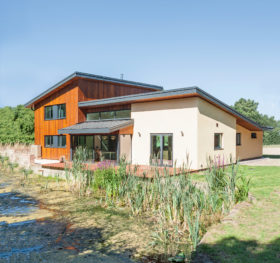































































































 Login/register to save Article for later
Login/register to save Article for later


